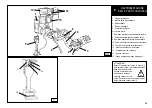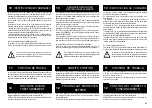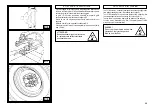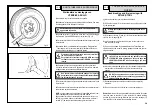
36
13.3_Montaggio con utensile a rullo.
1)
Assicurarsi che il cerchio sia bloccato sulla flangia.
2)
Lubrificare i talloni del pneumatico e il cerchio con il grasso in
dotazione.
3)
Serrare la pinza al bordo esterno del cerchio, nel punto più alto.
4)
Posizionare il pneumatico sulla pedana ed abbassare la flangia
per agganciare il primo tallone alla pinza (avendo cura di
mantenere quest'ultima nel punto più alto).
5)
Sollevare il cerchio con il pneumatico agganciato e ruotarlo in
senso antiorario di 15-20 cm. Il pneumatico si posizionerà in modo
obliquo rispetto al cerchio.
6)
Abbassare il braccio porta utensili (6, pag 20) in posizione di lavoro,
fino a che si sarà agganciato con l'apposito cricchetto.
Verificare sempre che il braccio sia correttamente
agganciato al carrello.
7)
Agendo sulle leve (7) (8) posizionare il rullo contro il secondo
tallone del pneumatico e ruotare il pneumatico fino a portare la pinza
nel punto piu basso. Il primo tallone dovrebbe essere entra- to. (Fig.
25)
8)
Posizionare il rullo a 4-5 mm. di distanza dal cerchio e premere
sul secondo tallone del pneumatico per inserire la pinza. (Fig. 25)
9)
Ruotare in senso orario lubrificando con apposito grasso e contem-
poraneamente fare avanzare il rullo a brevi scatti verso il centro
del cerchio fino al completo inserimento del pneumatico sul
cerchio. (Fig. 26).
10)
Togliere la pinza dal cerchione e portare il rullo in posizione di
fuori lavoro.
11)
Posizionare la pedana sotto la verticale della ruota e abbassare
il braccio porta flangia per adagiarvi sopra la ruota.
12)
Svitare la manovella di bloccaggio avendo cura di sostenere la
ruota per evitarne la caduta, traslare la pedana e rimuovere la
ruota stessa.
Questa operazione può essere estremamente pericolosa!
Effettuarla manualmente solo nel caso si sia assolutamente
sicuri di riuscire a mantenere in equilibrio la ruota. Le ruote
non devono mai essere sollevate dall'operatore, si deve farle
rotolare sul pavimento per ruote pesanti oltre 110 kg e/o di
grandi dimensioni (diametro oltre 130 cm) si DEVE utilizzare
un adeguato mezzo di sollevamento meccanico.
13.3_Tyre mounting with roller tool.
1)
Make sure that the rim is locked on the flange.
2)
Grease both beads and rim by means of the supplied grease.
3)
Fix the pliers at the outer rim edge at its highest point.
4)
Position the tyre on the plate and lower the flange to allow locking
the first bead with pliers (taking care to keep it at ist highest point)
5)
Lift the rim with the tyre fixed on it and turn it counterclockwise
of 15-20 cm. The tyre will position itself obliquely relating to the
rim
6)
Lower the tool-holder (6, pag 20) in its working position until it will
get hooked by the proper jack.
Check that the arm is correctly hooked to
the carriage
7)
By means of levers (7) and (8) position the roller against the
second tyre bead and turn the tyre until the pliers is in its
lowest point. First bead should be set in position (fig.25)
8)
Position the roller at a distance of 4-5 mm. from the rim and press
on second tyre bead in order to fit the pliers (fig.25)
9)
Turn clockwise and grease with the proper grease. At the same
time, let the roller move at brief steps towards the rim center until
it is completely set on the rim (fig.26)
10)
Remove the pliers from the rim and set the roller in resting po-
sition (out of work).
11)
Position the plate under the wheel vertical and lower the flange-
holding arm so as to set the wheel on it.
12)
Unscrew the locking handle taking care to hold up the wheel and
prevent a possible rolling down.
This operation can be extremely dangerous. Do
it manually only if you are certain you can keep
the wheel balanced. Heavy tyres (over 110kg)
and/or oversize tyres (with diameter over 130cm)
shall never be lifted by hand. Let them roll on
floor and lift them by means of an adequate me-
chanical lifting device.
Fig.25
Fig.26
Summary of Contents for S 561
Page 17: ...15 B 1 Min 1100 mm Min 1600 mm...




























